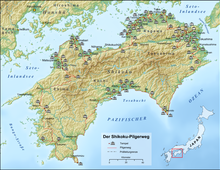
Back Pouť po Šikoku Czech Shikoku-Pilgerweg German Ŝikoku-pilgrimado Esperanto Camino de Shikoku Spanish Shikokuko erromesbidea Basque Shikokun pyhiinvaellusreitti Finnish Pèlerinage de Shikoku French Pellegrinaggio di Shikoku Italian 四国八十八箇所 Japanese 시코쿠 88개소 Korean







The Shikoku Pilgrimage (四国遍路, Shikoku Henro) or Shikoku Junrei (四国巡礼) is a multi-site pilgrimage of 88 temples associated with the Buddhist monk Kūkai (Kōbō Daishi) on the island of Shikoku, Japan. A popular and distinctive feature of the island's cultural landscape, and with a long history, large numbers of pilgrims, known as henro (遍路), still undertake the journey for a variety of ascetic, pious, and tourism-related purposes.[1] The pilgrimage is traditionally completed on foot, but modern pilgrims use cars, taxis, buses, bicycles, or motorcycles, and often augment their travels with public transportation. The standard walking course is approximately 1,200 kilometres (750 mi) long and can take anywhere from 30 to 60 days to complete.
In addition to the 88 "official" temples of the pilgrimage, there are 20 bekkaku (別格) temples, which are officially associated with the Shikoku Pilgrimage (and hundreds more bangai (番外) temples, simply meaning "outside the numbers," which are not considered part of the official 88).[2][3] To complete the pilgrimage, it is not necessary to visit the temples in order; in some cases, pilgrims complete the journey in reverse, a practice known as gyaku-uchi (逆うち).[4]
Henro (遍路) is the Japanese word for pilgrim,[5] and the locals along the route address the pilgrims as o-henro-san (お遍路さん). They are often recognizable by their white clothing, sedge hats, and kongō-zue or walking sticks. Alms or osettai (お接待) are frequently given to pilgrims by Shikoku's residents.
Before reaching Temple 88, walking and bicycle pilgrims can receive a "Shikoku 88 Temple Pilgrimage Henro Ambassador" certificate from the Maeyama Ohenro Koryu Salon. At Temple 88, one can purchase a pilgrimage completion certificate called a kechi-gan-shō (結願証), meaning "fulfillment of one's wishes."[6] Many pilgrims also begin and complete the journey by visiting Mount Kōya in Wakayama Prefecture, which was settled by Kūkai and remains the headquarters of Shingon Buddhism. The 21 kilometres (13 mi) walking trail up to Kōya-san still exists, but most pilgrims use the train.[citation needed]
- ^ Cite error: The named reference
Tanabewas invoked but never defined (see the help page). - ^ "Map (In Japanese)". Shikoku Bekkaku 20 Pilgrimage Official Website. Retrieved 17 September 2022.
- ^ "Temples, Shrines, and Religions of Shikoku: Bekkaku Temples". Henro.org. Retrieved 17 September 2022.
- ^ "Shikoku Pilgrimage Guide". Shikoku District Transport Bureau. Retrieved 17 September 2022.
- ^ Reader, Ian (2005). Making Pilgrimages: Meaning and Practice in Shikoku. University of Hawaii Press, p. 318. ISBN 978-0-8248-2907-0
- ^ "The Shikoku Pilgrimage: What Happens at the End of My Pilgrimage?". Henro.org. Retrieved 17 September 2022.